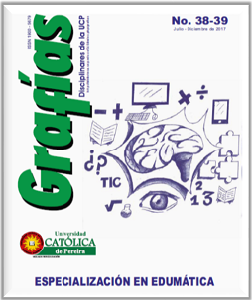Transmedia storytelling as strategy to stimulate in students of the school Hugo Angel Jaramillo the English oral production
DOI:
https://doi.org/10.31908/grafias.v0i38-39.1365Keywords:
communicative competence, oral production, transmedia storytelling, , ICT (information and communication)Abstract
This article describes the experience in designing and implementing a transmedia storytelling called “Can you guess who is the murderer?” This is a tool designed to promote oral production in English by strengthening vocabulary and a series of challenges performed by 9th grade students of the School Hugo Angel Jaramillo. Institution, located in Pereira, specifically in the Industrial Park neighborhood. Transmedia storytelling allows students face different challenges that involve the oral production of phrases, descriptions and questions using the vocabulary proposed in the game, which should be submitted as evidence to the group of what’s app and heading to different places to get more information by the English teachers, in this way they could solve the case described in the transmedia storytelling.
References
Brown, H. D. (1994). Teaching by Principles: An Interactive Approach to Language Pedagogy. New Jersey: PrenticeHall Regents.
Brown, D. (2007). Principles of Language Learning and Teaching (4ª Ed.). New York: Pearson Longman.
Chacón, C. (2006). Formación inicial y competencia comunicativa: percepciones de un grupo de docentes de inglés. Educere, 10(32), 121-130. Disponible en http://www.saber.ula.ve/bitstream/123456789/20057/2/ articulo15.pdf
Ellis, G., & Brewster, J. (2014). Tell it again!: the storytelling handbook for primary english language teachers. London: British Council.
Ferrés, J. (1992). Vídeo y educación. Barcelona: Paidós.
Gobierno departamental (2011). Proyecto de Ordenanza Política Educativa “Risaralda Bilingüe”. Disponible en http://mdbrisaralda.org/web/assets/images/ documentos/2.pdf
González Muñoz, D. A. (2009). Estrategias de aprendizaje para el desarrollo de la producción oral en la Licenciatura en Lenguas Modernas de la Pontificia Universidad Javeriana (Bachelor’s thesis, Facultad de Comunicación y Lenguaje). Disponible en http://www.javeriana.edu.co/biblos/tesis/comunicacion/tesis471.pdf
Granda, C. (2012). Los aprendizajes mixtos para el desarrollo de las cuatro macro competencias en inglés en estudiantes de ingeniería. Argentina: Universidad Nacional de General Sarmiento.. Disponible en https:// ungs.academia.edu/CristinaGranda
Harmer, J. (2009). How to Teach English. England: Pearson Longman.
MEN (2006). Estándares Básicos de Competencias en Lenguas Extranjeras: inglés. Bogotá: Autor.
Morales Ríos, S. y Ferreira Cabrera, A. (2008). La efectividad de un modelo de aprendizaje combinado para la enseñanza del inglés como lengua extranjera: estudio empírico. RLA. Revista de lingüística teórica y aplicada, 46(2), 95-118.
Moreno, W. y Pulido, S. (2007). Educación, cuerpo y ciudad. El cuerpo en las interacciones e instituciones sociales. Medellín: Universidad de Antioquia.
Newton, J., & Nation, I. P. (1997). Vocabulary and teaching. Second language vocabulary acquisition, 238-254.
Oxford, R. (1990). Language Learning Strategies: What every teacher should know. Boston, Heinle and Heinle publishers. Recomendaciones el Parlamento Europeo de 18 de diciembre de 2006, sobre las competencias claves para el aprendizaje permanente. Disponible en http://europa.eu/legislation_summaries/education_training_ youth/lifelong_learning/c11090_es.htm
Pacheco, D. J. y Vázquez, E. A. (2006). La competencia comunicativa y su relación con la enseñanza del idioma inglés en las ciencias biomédicas. Gaceta Médica Espirituana, Universidad Ciencias Médicas, 8(3). Disponible en http://revgmespirituana.sld.cu/index.php/gme/article/view/901/826
Piña, E., García, F. y Govea, L. (2010). Estrategias de enseñanza basadas en un wiki para el desarrollo de la destreza escrita en estudiantes de inglés como lengua extranjera. Télématique, 8(2), 28-43.
Richards, J. C. (2008). Teaching listening and speaking. Cambridge: Cambridge University Press.
Samuel, R. & Bakar, Z. (2006, May 31). The utilization and integration of ICT tools in promoting English language Teaching and Learning: Reflections from English Option Teachers in Kuala Langat District, Malaysia. International Journal of Education and Development using ICT. Disponible en: http://ijedict.dec.uwi.edu/viewarticle. php?id=161.
Scolari, C. (2013). Narrativas transmedia. Cuando todos los medios cuentan. Disponible en http://www.um.es/tic/LECTURAS%20 FCI-II/Aportaciones%202013/ScolariNarrativas%20transmedia-Cap1.pdf
Thanajaro, M. (2000). Using authentic materials to develop listening comprehension in the English as a second language classroom (Doctoral dissertation, Virginia Tech). Disponible en https://vtechworks. lib.vt.edu/bitstream/handle/10919/26336/ Metinee1.pdf?sequence=2&isAllowed=y
UNESCO (s.f.). Languages in Education. Disponible en http://www.unesco.org/ new/en/education/themes/strengtheningeducation-systems/languages-in-education/strategy/
Urrutia, W. & Vega, E. (2012). Encouraging teenagers to improve speaking skills through games in a Colombian public school. Profile, 12 (1), 11-31. Disponible en http://www. scielo.org.co/pdf/prf/v12n1/v12n1a02.pdf


